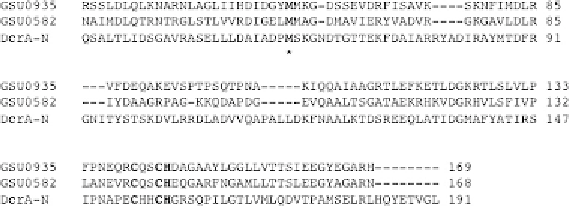Biology Reference
In-Depth Information
Figure 7.13 Amino acid sequence alignments among the periplasmic haem-binding
PAS domains of GSU0582, GSU0935, and DcrA-N. The conserved Cys in the Cys-x-x-
Cys-His motif and Met are shown in bold.
the
n
(Fe-CO) and
n
(C-O) bands at 493 and 1955 cm
1
, respectively. The
correlation between the
n
(Fe-CO) and
n
(C-O) bands reveals that a neutral
His is the proximal ligand of the CO-bound haem (
Yoshioka et al., 2005
).
Thus, the ligand exchange between the endogenous axial ligand and CO
takes place upon CO binding. These properties for the coordination struc-
tures of the haem and ligand exchange upon CO binding are same as those of
GSU0935
and GSU0582. However,
the CO-binding
affinity
(
K
d
¼
138
m
M)
is
lower by 1700-
and 2700-fold compared with
GSU0935 (
K
d
0.05
m
M).
D. vulgaris
pos-
sesses the
coo
operon encoding the proteins for COmetabolism (
Voordouw,
2002
), suggesting that it can gain energy for growth by COmetabolism. If it
is the case, it makes sense there is a chemotaxis regulation system sensing
suitable concentrations of CO. DcrA would be a possible candidate of a
CO sensor with a low CO-binding affinity to sense the existence of enough
concentrations of CO for gaining energy by CO metabolism. This is an
attractive hypothesis, but more experiments are required to prove whether
or not it is the case.
¼
0.08
m
M) and GSU0582 (
K
d
¼
7. CONCLUSION
Haem-containing PAS domains are widely used as a sensory module
in sensor proteins that sense various environmental cues. Haem acts as the
active site for sensing the cognate physiological signals in these sensor pro-
teins. Binding of a gas molecule to the haem is the first step of sensing the
physiological effector in gas sensor proteins, while the change in the oxida-
tion state of the haem is the first cue in redox sensors. As various external
ligands can be bound to the haem, haem-based sensor proteins should




